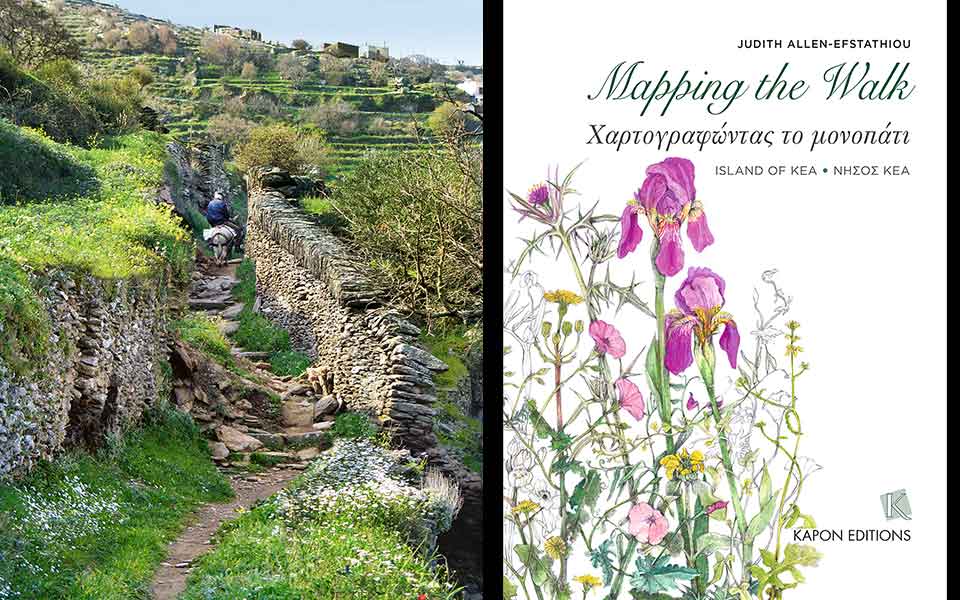Every month for the past 11 years, artist Judith Allen-Efstathiou documented the life cycles of plants on her Cycladic island home by making beautiful drawings of the wild flowers that grow along an ancient path near her house in Ioulida (Chora). The enchanting drawings, minutely detailed and full of color, tell the story of the route and its flora – both threatened with destruction by a proposed asphalt pavement.
“Mapping the Walk is a record of my walks, a series of detailed graphite and gouache drawings that record the ephemeral life cycle of plants along the path. With my drawings I honor and document, in my own way, the path” writes Judith Allen-Efstathiou in the book. “I am not a botanist, not even a serious gardener, and until I started this project my botanical interest was limited to identifying and collecting edible plants in season, such as wild grasses, herbs, mushrooms and capers. But through walking and drawing I learned to recognize the flowering plants that grow wild on this small section of the trail and to admire their diversity.”
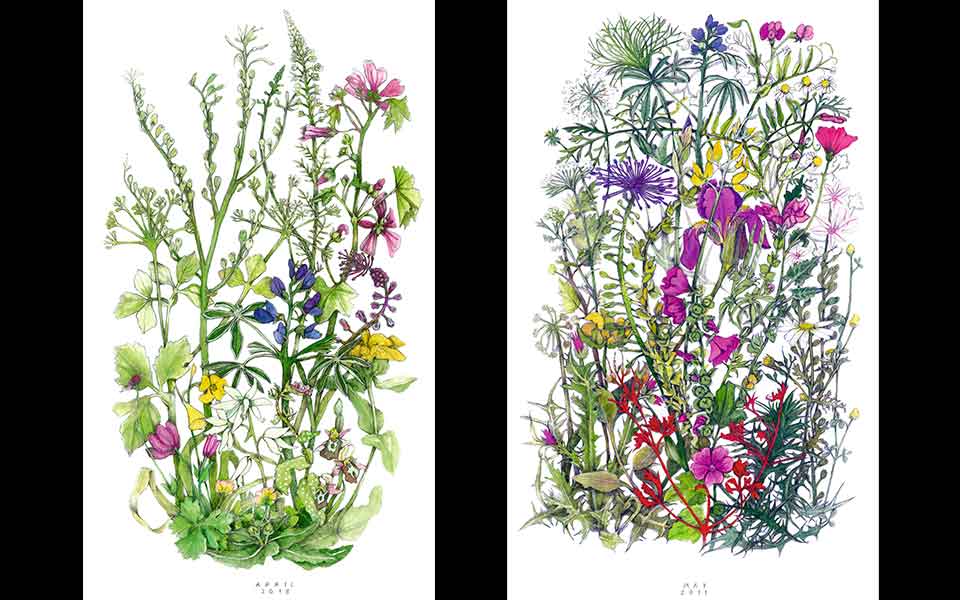
© Judith Allen-Efstathiou / Kapon Editions
The result of this 11-year endeavor is a richly illustrated bilingual (Greek and English) book, elegantly produced by the Greek publishing house Kapon Editions. “Mapping the Walk” features 53 color botanical drawings, as well as sketches and photographs that document the course of the ancient path on Kea. The work is a love letter to the beauty and resilience of nature.
“I’ll start my note with a confession: Judith Allen-Efstathiou’s designs are the most beautiful I’ve seen in person,” Eleni Martinou, an art dealer and gardening enthusiast, says in the foreword to the book. “In her designs we follow the life cycle of plants from the prime of their beauty to their complete withering. Each time she puts forward the new vibrant flowers, while in the background she draws the dried, finite ones. While she is not a botanist herself, her drawings are of absolute botanical accuracy, and therefore extremely valuable scientifically,” she concludes.
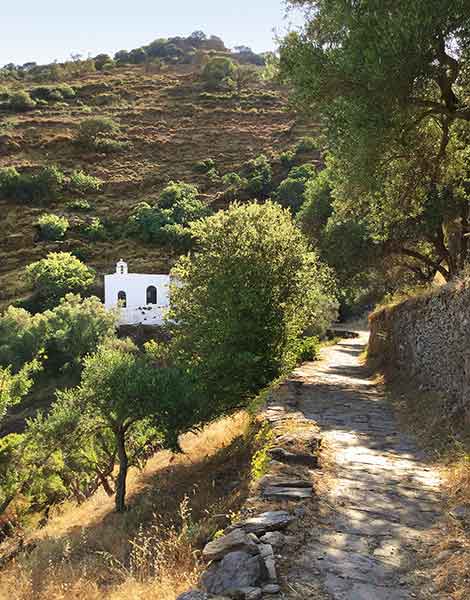
© Judith Allen-Efstathiou / Kapon Editions
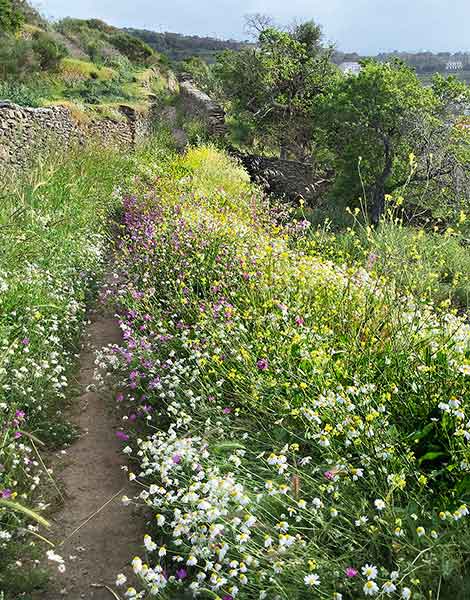
© Judith Allen-Efstathiou / Kapon Editions
The artist first encountered the old cobblestone path that links the island’s capital (Chora) Ioulida to the village of Otzias in the early 1970s. Like many visitors to the island, she followed the path to view an impressive ancient sculpture of a lion, one of the island’s best-known attractions. The sculpture, which marks the beginning of the path, is thought to have been carved in the early Archaic period, sometime between the end of the 7th and early 6th century BC.
In 1981, enchanted by the island’s beauty, Judith and her husband bought their house in Ioulida. As a nature lover and keen walker, their choice of island made perfect sense. Cycladic Kea, located one hour by ferry from the port of Lavrio on the east coast of Attica, is blessed with an extensive network of paths, ideal for hiking.
“Since then I have walked countless times to the ancient Leo. Sometimes I continued north, past the Fountain of Benjamin, and turned towards the valley for Otzias, and sometimes I walked to Agios Dimitrios and followed the path behind the small church to Pera Meria or turned back by making the circle and by the upper path, after Vrysi in Pyrgi, towards Ano Chora. Sometimes I would walk to Kastriani and spend the night in the monastery or go down the valley to the beach at Spathi for a swim. I feel lucky that I managed to walk all those paths before many of them were destroyed by the bulldozers and turned into paved roads,” she notes.
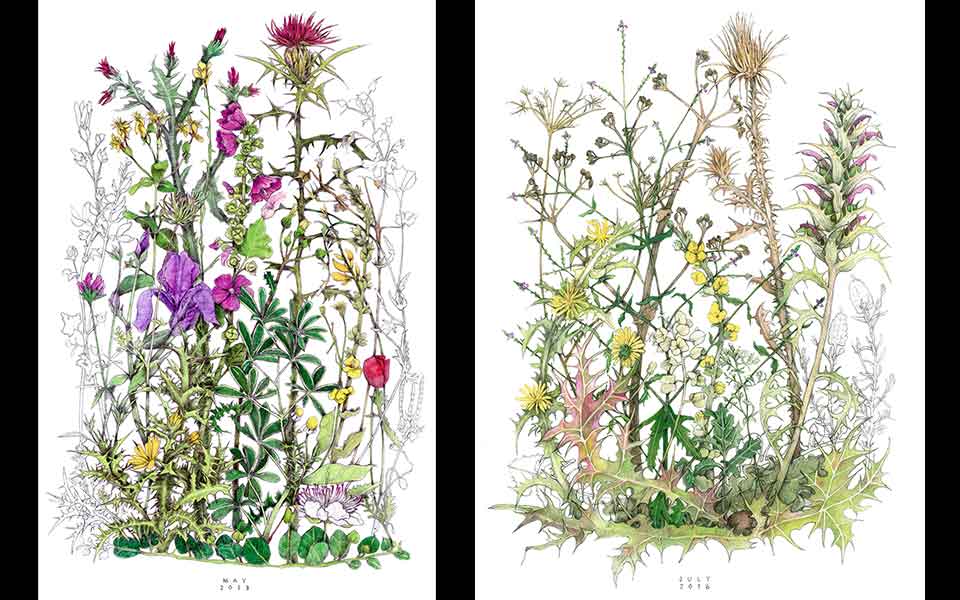
© Judith Allen-Efstathiou / Kapon Editions
The old path to the ancient lion sculpture has been praised by a number preeminent visitors over the centuries, including the French botanist Joseph Pitton, who visited the island in 1700. In his account, he described the path as “perhaps the most beautiful road in Greece,” while British explorer and archaeologist Theodore Bend, writing in the late 19th century, called the route “one of the most enchanting walks in the world.”
As for the future of the ancient path and its wildflowers, so beautifully captured by the artist, the book, in addition to being a celebration of the beauty and resilience of nature, hopes to act as inspiration for its preservation, and for other hiking trails on Kea.
“Today, only a small section of the cobblestones for Kastriani is preserved: It starts from Chora, passes by the ancient Leo and the Fountain of Benjamin and ends at the asphalt road in front of the church of Aghios Dimitrios. In 2011, the attempt to pave the remaining part of it with asphalt was prevented thanks to the protests of the residents and the intervention of the Archaeological Service. At the time I wanted to express my protest too, so I started a ritual that involved daily walks on the path during the months I was on the island,” writes the author about why she began documenting the wildflowers on her walks.
Available in paperback, “Mapping the Walk” can be purchased on the Kapon Editions website.

